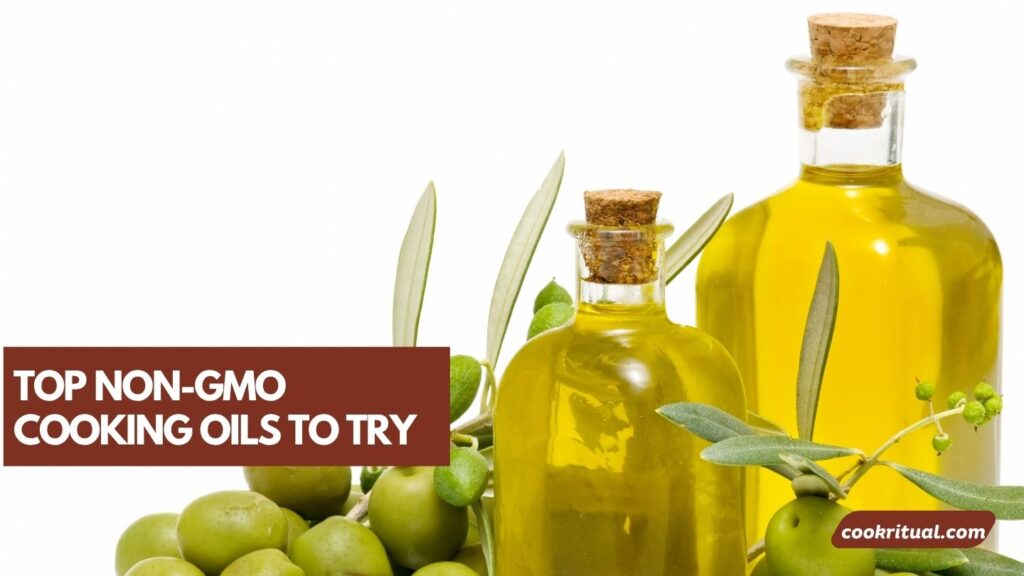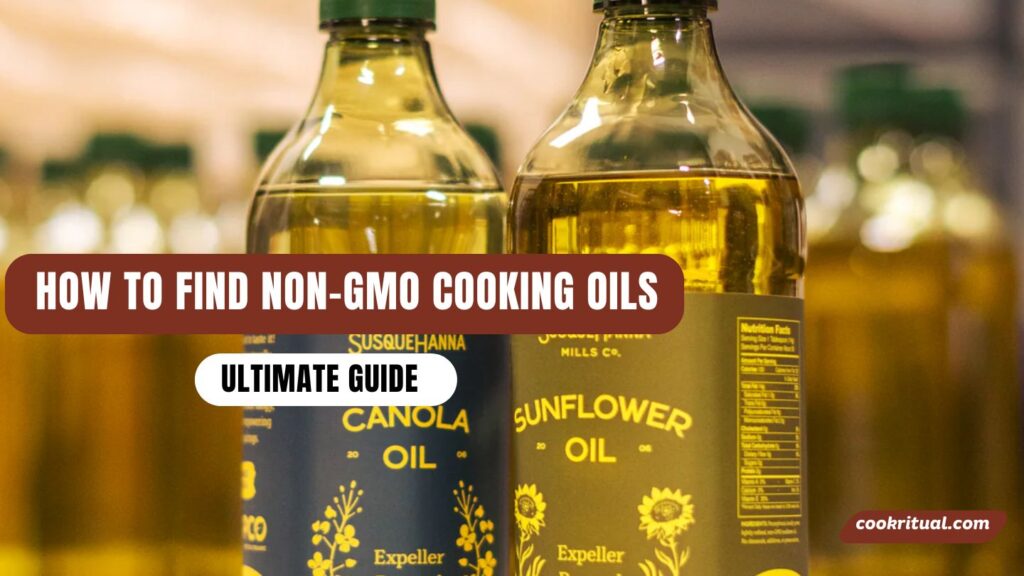Finding non-GMO cooking oils doesn’t have to be complicated—it just takes a little know-how and label-reading confidence. With more shoppers becoming health-conscious and environmentally aware, non-GMO oils are gaining popularity in everyday kitchens across the United States. Whether we’re sautéing veggies, roasting sweet potatoes, or making homemade salad dressings, the type of oil we use matters.
But let’s face it—standing in the oil aisle can be overwhelming. Between cold-pressed, expeller-pressed, organic, and non-GMO labels, it’s hard to know what’s actually good for our health and what’s just clever marketing. That’s where this guide comes in.
In this ultimate guide, we’ll walk through everything we need to know to confidently choose non-GMO cooking oils that are both nutritious and safe for our families. From label tips and brand recommendations to cooking techniques and common myths, we’ll cover it all—clearly, simply, and from a real-life kitchen perspective.
Contents
- 1 What Are Non-GMO Cooking Oils?
- 2 Benefits of Choosing Non-GMO Oils
- 3 How to Identify Non-GMO Cooking Oils: Step-by-Step Guide
- 4 Top Non-GMO Cooking Oils to Try
- 5 Non-GMO Oil Brands Worth Exploring
- 6 GMO vs. Non-GMO Cooking Oils: Key Differences
- 7 Cooking With Non-GMO Oils: Tips and Best Practices
- 8 Where to Buy Non-GMO Cooking Oils
- 9 Non-GMO Cooking Oil Alternatives for Special Diets
- 10 FAQs: What Shoppers Ask About Non-GMO Oils
- 11 Final Tips and Actionable Takeaways
- 12 Conclusion
What Are Non-GMO Cooking Oils?

When we talk about non-GMO cooking oils, we’re referring to oils made from plants that haven’t been genetically modified. GMOs (genetically modified organisms) are crops that have been altered in labs to resist pests or grow faster. While that might sound helpful, many people choose to avoid them due to health or environmental concerns.
Non-GMO oils come from crops grown the natural way, without lab-engineered changes. These oils are not only closer to nature but also easier for our bodies to handle. To be sure an oil is non-GMO, it’s best to look for the Non-GMO Project Verified seal on the label.
Common GMO Oils to Avoid
Some oils are more likely to come from GMO crops. If the label doesn’t say “non-GMO,” it’s safe to assume these might be genetically modified:
- Soybean oil
- Corn oil
- Canola oil
- Cottonseed oil
- Vegetable oil blends (unless specified)
Choosing non-GMO oils means we’re skipping over highly processed options that often show up in packaged foods and fast food meals.
Benefits of Choosing Non-GMO Oils
Switching to non-GMO oils doesn’t just sound nice—it comes with real benefits for our health and the planet.
Health Benefits
- Fewer chemicals: Non-GMO crops are often grown without harsh pesticides linked to health issues.
- Cleaner nutrition: These oils are less likely to be heavily processed or treated with synthetic additives.
- Better fat quality: Many non-GMO oils are also cold-pressed or virgin, which keeps healthy fats intact.
According to the Harvard T.H. Chan School of Public Health, choosing oils with healthy unsaturated fats (like olive or avocado oil) may lower bad cholesterol and support heart health.
Environmental and Ethical Benefits
- Support for sustainable farming: Many non-GMO crops are grown by farmers using eco-friendly methods.
- Less soil and water contamination: These crops tend to use fewer synthetic fertilizers and chemicals.
- Greater transparency: Non-GMO labeling encourages clearer communication between food brands and shoppers.
Going non-GMO helps us support food systems that care for people and the planet.
How to Identify Non-GMO Cooking Oils: Step-by-Step Guide
Knowing what to look for on a label can make all the difference. Here’s how we can spot a true non-GMO oil in just a few steps:
Step 1: Look for Trusted Certifications
Labels are key. These are the most trusted badges to find on cooking oil bottles:
| Certification | What It Means | Where to Find It |
| Non-GMO Project Verified | Product is tested and meets strict non-GMO standards | Usually on the front label |
| USDA Organic | Organic crops can’t be genetically modified | Found on both front and back labels |
If a product has both seals, that’s a strong sign it’s non-GMO and also free from synthetic pesticides and additives.
Step 2: Check the Ingredient List
Sometimes the front label is vague. Flip the bottle and look at the back. Watch for:
- Blended oils (e.g., “vegetable oil”)
- Additives or flavor enhancers
- Unnamed seed sources (like “plant-based oil”)
Step 3: Learn to Spot Red Flags
Some terms sound healthy but don’t mean much. Be cautious of:
- “Natural” – This has no legal definition in the U.S.
- “Pure” – Often just a marketing term
- “Made with non-GMO ingredients” – This may mean only part of the product is non-GMO
Step 4: Research the Brand
Look up the brand’s website or check the Non-GMO Project’s product database. Reputable brands are transparent about sourcing and often list where their oils come from.
By following these simple steps, we can shop smarter and bring better oils into our kitchens.
Top Non-GMO Cooking Oils to Try

When choosing non-GMO oils, it helps to know which ones are safe, healthy, and versatile in the kitchen. Here are some top options to keep on hand:
Olive Oil (Cold-Pressed, Organic)
Olive oil is a kitchen staple, especially when it’s cold-pressed and organic. It’s rich in healthy fats and antioxidants. Perfect for salad dressings, light sautéing, and finishing dishes. It has a medium smoke point, so avoid high-heat frying.
Coconut Oil (Unrefined, Virgin)
Virgin coconut oil is naturally non-GMO and has a distinct, tropical flavor. It’s solid at room temperature and great for baking or medium-heat cooking. It’s praised for its medium-chain triglycerides (MCTs), which some studies link to health benefits.
Avocado Oil (High Smoke Point)
Avocado oil has a very high smoke point, making it excellent for frying, roasting, or grilling. It’s loaded with monounsaturated fats and vitamin E. Look for cold-pressed, organic versions to avoid GMO sources.
Sunflower Oil (Expeller-Pressed)
Sunflower oil can be non-GMO when it’s expeller-pressed. It’s light and mild in flavor, suitable for baking and stir-frying. Be sure to check labels for Non-GMO Project verification, as sunflower crops may sometimes be genetically modified.
Using these oils helps ensure you cook healthily without compromising flavor or safety.
Non-GMO Oil Brands Worth Exploring
Picking the right brand matters just as much as choosing the oil type. Some brands are trusted leaders in the non-GMO space. Here are a few we recommend:
| Brand | Highlights | Where to Buy |
| Spectrum Naturals | Non-GMO Project Verified, organic options | Grocery stores, Amazon |
| La Tourangelle | Cold-pressed, artisan-quality oils | Specialty stores, online |
| Nutiva | Focus on organic, coconut, and avocado oils | Health food stores, Amazon |
| Chosen Foods | Non-GMO avocado and coconut oils | Online, natural food stores |
Before buying, it’s wise to visit the brand’s website to check their sourcing and certification claims. Trusted brands offer transparency and often share their farming partners and processing methods.
GMO vs. Non-GMO Cooking Oils: Key Differences
Understanding the differences between GMO and non-GMO oils helps us make better choices. Here’s a quick look at what sets them apart:
| Aspect | GMO Cooking Oils | Non-GMO Cooking Oils |
| Source | Genetically modified crops | Naturally grown, non-altered crops |
| Nutritional Value | Often more processed, fewer nutrients | Retain more natural fats and antioxidants |
| Health Impact | Potential exposure to pesticides and additives | Lower pesticide residues, cleaner fats |
| Environmental Impact | Can harm biodiversity, soil, and water | Support sustainable farming practices |
| Labeling | Rarely labeled as GMO | Verified by Non-GMO Project or USDA Organic |
Choosing non-GMO oils means opting for products that are better for health and the environment. It also supports farmers committed to natural growing methods.
Cooking With Non-GMO Oils: Tips and Best Practices
Using non-GMO oils the right way helps us get the most nutrition and flavor out of them. Here are some simple tips:
Match Oils to Cooking Methods
- Sautéing and Stir-Frying: Use oils with medium to high smoke points like avocado or expeller-pressed sunflower oil.
- Baking: Coconut oil or olive oil works well and adds a nice flavor.
- Dressings and Finishing: Cold-pressed olive oil is perfect for drizzling over salads or dishes after cooking.
Understand Smoke Points
The smoke point is the temperature at which an oil starts to break down and lose quality. Cooking above this point can create harmful compounds. Non-GMO oils often list their smoke points, but you can also find reliable charts like those from the American Heart Association.
Storage and Shelf Life
Store oils in a cool, dark place to keep them fresh longer. Some oils, like flaxseed oil, need refrigeration. Always check the expiration date and smell the oil before use. A rancid smell means it’s time to toss.
Where to Buy Non-GMO Cooking Oils
Finding non-GMO oils is easier than ever, but knowing where to look helps save time and money.
Online Marketplaces
- Amazon: Wide selection with customer reviews and Non-GMO certifications.
- Thrive Market: Specializes in organic and non-GMO products with discounted prices.
Grocery Stores
Look in the natural foods or organic sections of stores like Whole Foods, Trader Joe’s, or your local co-op. Many mainstream supermarkets now carry non-GMO oils in the cooking oil aisle.
Buying in Bulk vs. Small Batches
Buying larger bottles saves money, but oils degrade over time once opened. If you don’t cook often, smaller bottles keep oil fresher. Consider buying bulk for oils you use daily and smaller sizes for specialty oils.
Non-GMO Cooking Oil Alternatives for Special Diets
For those with dietary needs or preferences, there are plenty of non-GMO oil options to fit different lifestyles:
| Diet Type | Recommended Non-GMO Oils | Notes |
| Vegan | Olive oil, avocado oil, sunflower oil | Most plant oils are naturally vegan |
| Paleo | Coconut oil, avocado oil | Emphasizes unprocessed, whole foods |
| Keto | MCT oil (from coconut), avocado oil | High-fat oils support keto fat intake |
| Allergy-Friendly | Sunflower oil, olive oil | Avoid oils like soybean if allergic |
| Budget-Friendly | Expeller-pressed sunflower oil, canola oil* | Look for verified non-GMO brands |
*Canola oil is often GMO, so only buy if it’s labeled non-GMO.
These options help ensure no one misses out on healthy fats, no matter the diet.
FAQs: What Shoppers Ask About Non-GMO Oils
What does “non-GMO” really mean on oil labels?
“Non-GMO” means the oil is made from plants that haven’t been genetically modified in a lab. Look for seals like the Non-GMO Project Verified to be sure.
Are non-GMO oils healthier than regular oils?
Generally, yes. Non-GMO oils often have fewer pesticides and less processing, which can keep healthy nutrients intact. The Harvard T.H. Chan School of Public Health highlights that choosing quality oils benefits heart health.
Can I use non-GMO oils for high-heat cooking?
Some non-GMO oils like avocado and expeller-pressed sunflower oil have high smoke points suitable for frying and roasting. Olive oil and coconut oil are better for medium or low heat.
Are organic oils always non-GMO?
Organic oils cannot use GMO crops by law, so yes, USDA Organic certified oils are also non-GMO. But not all non-GMO oils are organic.
How do I store non-GMO oils to keep them fresh?
Keep oils in a cool, dark place. Refrigerate sensitive oils like flaxseed. Always check expiration dates and discard if the oil smells rancid.
Final Tips and Actionable Takeaways
- Always check for Non-GMO Project Verified or USDA Organic seals to avoid guesswork.
- Match oil types to cooking methods to keep nutrients and flavors intact.
- Buy from trusted brands that share their sourcing and processing details.
- Store oils properly to maintain freshness and avoid waste.
- Explore alternatives to suit your diet and budget without sacrificing quality.
By choosing non-GMO cooking oils, we support healthier kitchens and a cleaner planet. Small changes in what we cook with can make a big difference.
Conclusion
Finding and using non-GMO cooking oils is a simple step toward healthier meals and a more sustainable lifestyle. By understanding what non-GMO means, recognizing top oils, and knowing how to shop smart, we can confidently bring better oils into our daily cooking routines.
Non-GMO oils offer cleaner nutrition, fewer chemicals, and support for farming that respects nature. With a little practice reading labels and exploring brands, choosing these oils becomes second nature.


